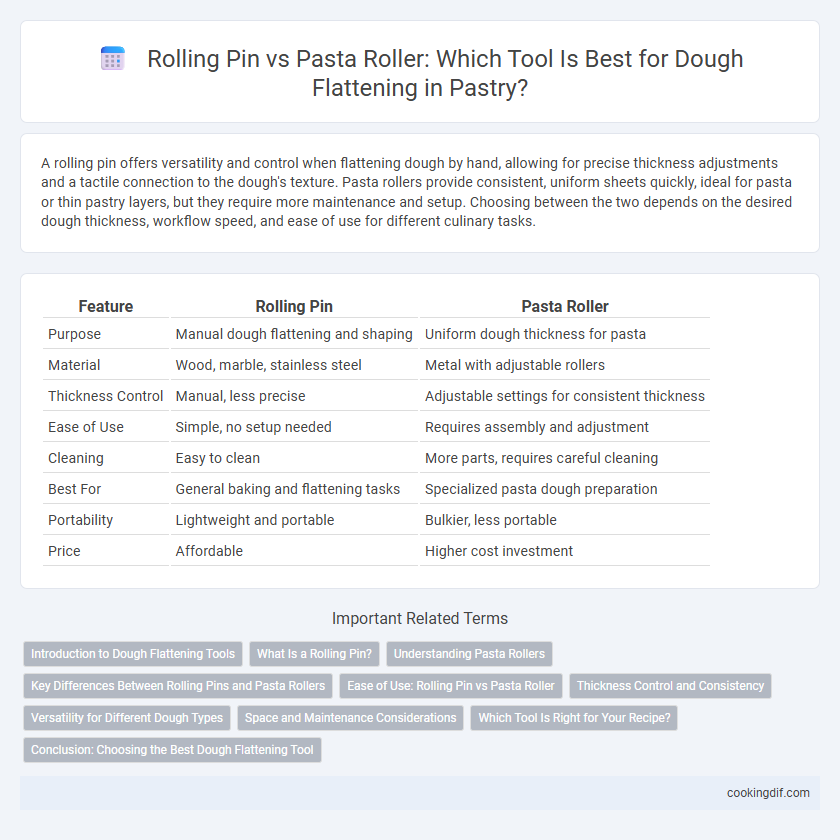A rolling pin offers versatility and control when flattening dough by hand, allowing for precise thickness adjustments and a tactile connection to the dough's texture. Pasta rollers provide consistent, uniform sheets quickly, ideal for pasta or thin pastry layers, but they require more maintenance and setup. Choosing between the two depends on the desired dough thickness, workflow speed, and ease of use for different culinary tasks.
Table of Comparison
| Feature | Rolling Pin | Pasta Roller |
|---|---|---|
| Purpose | Manual dough flattening and shaping | Uniform dough thickness for pasta |
| Material | Wood, marble, stainless steel | Metal with adjustable rollers |
| Thickness Control | Manual, less precise | Adjustable settings for consistent thickness |
| Ease of Use | Simple, no setup needed | Requires assembly and adjustment |
| Cleaning | Easy to clean | More parts, requires careful cleaning |
| Best For | General baking and flattening tasks | Specialized pasta dough preparation |
| Portability | Lightweight and portable | Bulkier, less portable |
| Price | Affordable | Higher cost investment |
Introduction to Dough Flattening Tools
Rolling pins and pasta rollers are essential tools for dough flattening, each offering unique advantages in texture and thickness control. Rolling pins provide manual flexibility and are ideal for small batches or uneven dough surfaces, while pasta rollers deliver consistent, precise thickness, especially for pasta sheets. Choosing the right tool depends on the type of dough and desired uniformity in flattening results.
What Is a Rolling Pin?
A rolling pin is a cylindrical kitchen tool traditionally made of wood, marble, or silicone, designed to evenly flatten dough for pastries, cookies, and bread. Its simple structure allows precise control over thickness through manual pressure and movement, making it versatile for various dough consistencies. Unlike pasta rollers, rolling pins do not have adjustable thickness settings but offer direct tactile feedback essential for delicate dough handling.
Understanding Pasta Rollers
Pasta rollers provide consistent thickness control with adjustable settings that ensure even dough flattening, essential for delicate pasta sheets, while traditional rolling pins require manual skill and pressure for uniformity. The stainless steel rollers in pasta machines reduce effort and save time, delivering precise results ideal for recipes demanding exact dough thickness. Understanding pasta rollers highlights their efficiency in achieving professional-quality pasta textures compared to the variable results of rolling pins.
Key Differences Between Rolling Pins and Pasta Rollers
Rolling pins offer versatile control for flattening various dough types, allowing manual pressure adjustment for thickness and texture customization. Pasta rollers provide consistent, uniform dough sheets through adjustable rollers, enhancing precision and efficiency in pasta making. Key differences include the level of automation, ease of achieving uniform thickness, and suitability for specialized dough shapes versus general-purpose flattening.
Ease of Use: Rolling Pin vs Pasta Roller
A rolling pin offers straightforward ease of use with minimal setup, allowing for quick and intuitive dough flattening by hand. A pasta roller requires more time for assembly and adjustment but ensures uniform thickness and consistent results with less manual effort. Both tools cater to different skill levels, with the rolling pin favored for simplicity and the pasta roller for precision in dough preparation.
Thickness Control and Consistency
A rolling pin offers manual thickness control with variability depending on user skill, often resulting in less consistent dough sheets. A pasta roller provides precise, adjustable settings that ensure uniform thickness and consistent dough texture, ideal for repetitive tasks. For achieving standardized dough thickness and professional-quality consistency, a pasta roller outperforms a traditional rolling pin.
Versatility for Different Dough Types
A rolling pin offers exceptional versatility for various dough types, from pie crusts to cookie dough, allowing precise control over thickness and texture. Pasta rollers are specialized tools primarily designed for laminating pasta dough, ensuring uniform thin sheets ideal for lasagna or ravioli but less adaptable for other pastry doughs. For bakers seeking multifunctionality across diverse dough recipes, a rolling pin remains the preferred and more flexible option.
Space and Maintenance Considerations
A rolling pin requires minimal storage space and is easy to clean, making it ideal for small kitchens with limited countertop area. A pasta roller, while providing more uniform dough thickness, demands more storage room and involves more parts to maintain, including regular cleaning of rollers and gears. Choosing between the two depends on kitchen size and willingness to invest time in maintenance versus convenience.
Which Tool Is Right for Your Recipe?
A rolling pin offers versatile control for flattening pastry dough to varying thicknesses, ideal for pie crusts, cookies, and rustic pastries requiring manual pressure adjustments. Pasta rollers excel at producing uniformly thin sheets quickly, perfect for delicate doughs like pasta, strudel, or layered pastries where consistent thickness enhances texture and cooking time. Choosing the right tool depends on recipe precision needs and dough type, with rolling pins favored for artisanal feel and pasta rollers suited for efficiency and uniformity in thin dough preparation.
Conclusion: Choosing the Best Dough Flattening Tool
A rolling pin offers versatility and simplicity for dough flattening, making it ideal for home bakers seeking control and ease of use. Pasta rollers provide consistent thickness and efficiency, especially beneficial for thin, uniform pasta dough sheets in professional or frequent cooking environments. Selecting the best tool depends on dough type, desired thickness precision, and user experience level, ensuring optimal results for each baking task.
Rolling pin vs Pasta roller for dough flattening Infographic

 cookingdif.com
cookingdif.com